Abstract
Recent studies show that most patients with X-linked hyper IgM syndrome have defects in the gene for CD40 ligand. We evaluated 17 unrelated males suspected of having X-linked hyper IgM syndrome. Activated T cells from 13 of the 17 patients failed to bind a soluble CD40 construct. In these patients, the sequence of CD40 ligand demonstrated mutations. By contrast, T cells from the remaining four patients exhibited normal binding to the CD40 construct. Sequencing of the cDNA for CD40 ligand from these patients did not show mutations. The possibility that hyper IgM syndrome in these four patients was due to abnormalities in the B cell response to CD40-mediated signals was examined. Peripheral blood lymphocytes were stimulated with anti-CD40 alone, IL4 alone or anti-CD40 plus IL4. In comparison with B cells from controls or patients with hyper IgM syndrome and mutant CD40 ligand, B cells from the patients with hyper IgM syndrome and normal CD40 ligand were defective in their ability to secrete IgE (P < 0.02) or express activation markers, CD25 and CD23 (P < 0.02) in response to stimulation with anti-CD40. The failure of these B cells to respond to CD40-mediated activation could not be attributed to a generalized deficiency in B cell activation because IL4 induced normal up-regulation of CD23 and CD25 expression. These findings indicate that hyper IgM syndrome may result from defects in expression of CD40 ligand by activated T cells or defects in CD40-mediated signal transduction in B cells.
Full text
PDF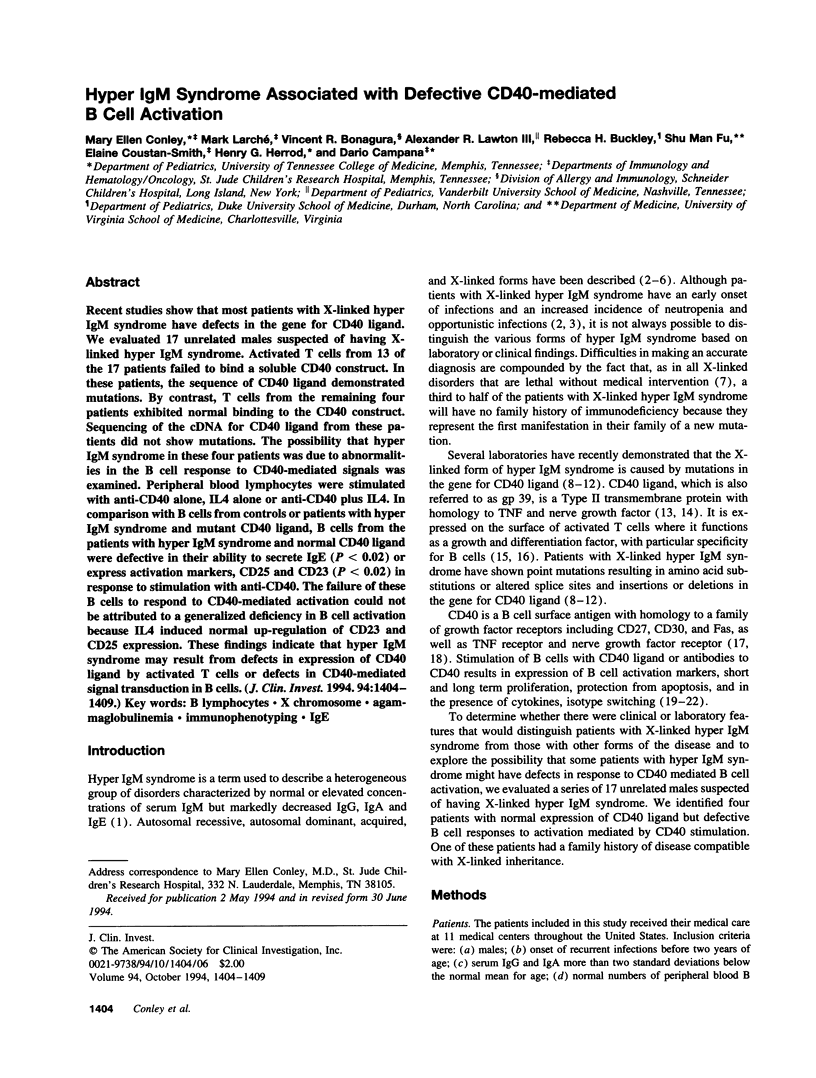
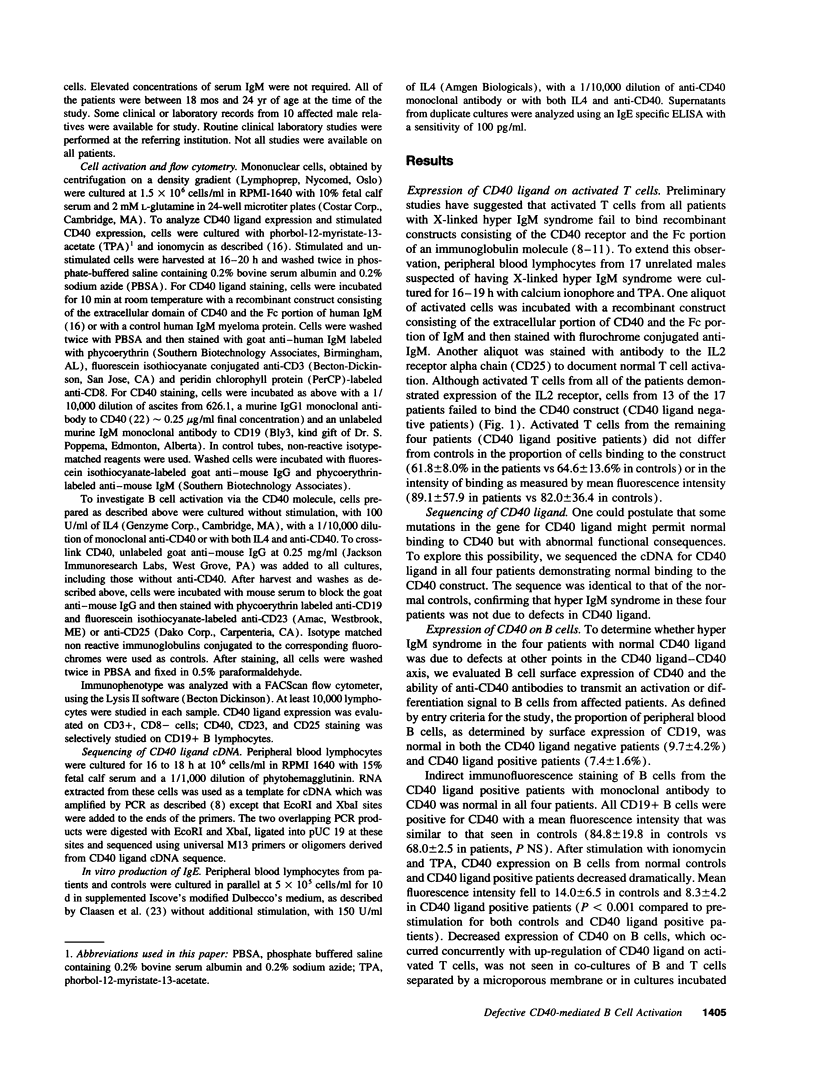
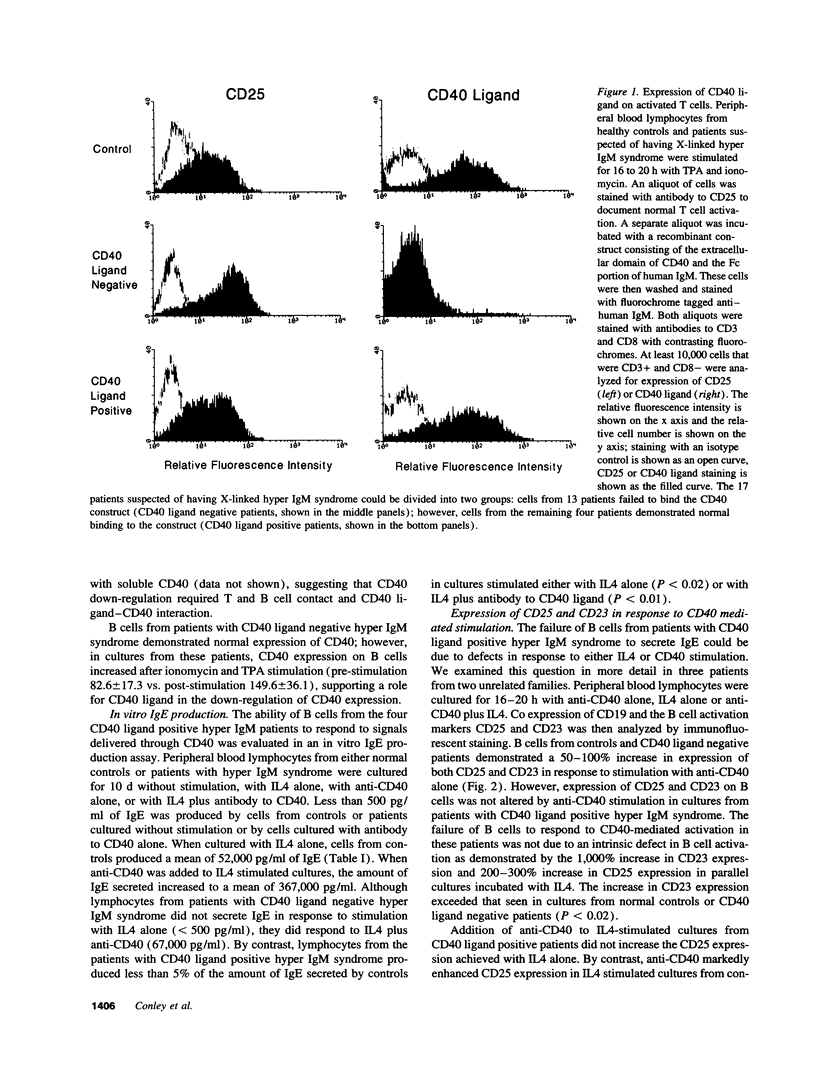
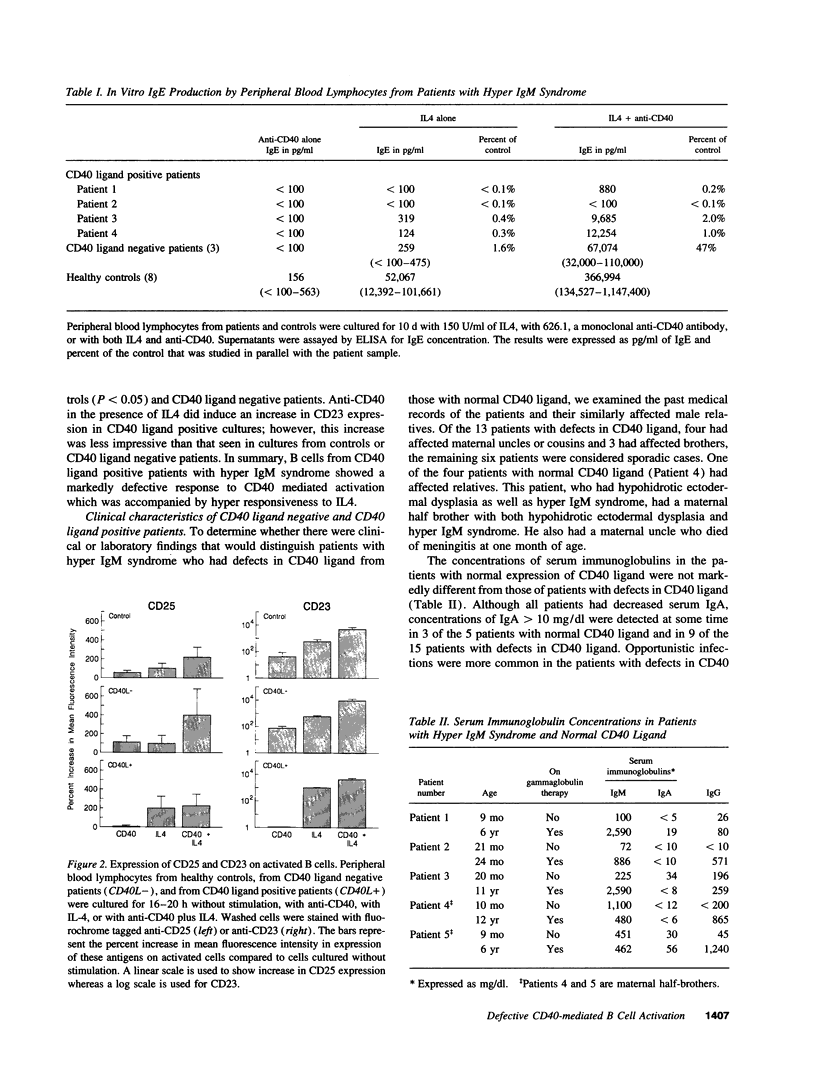
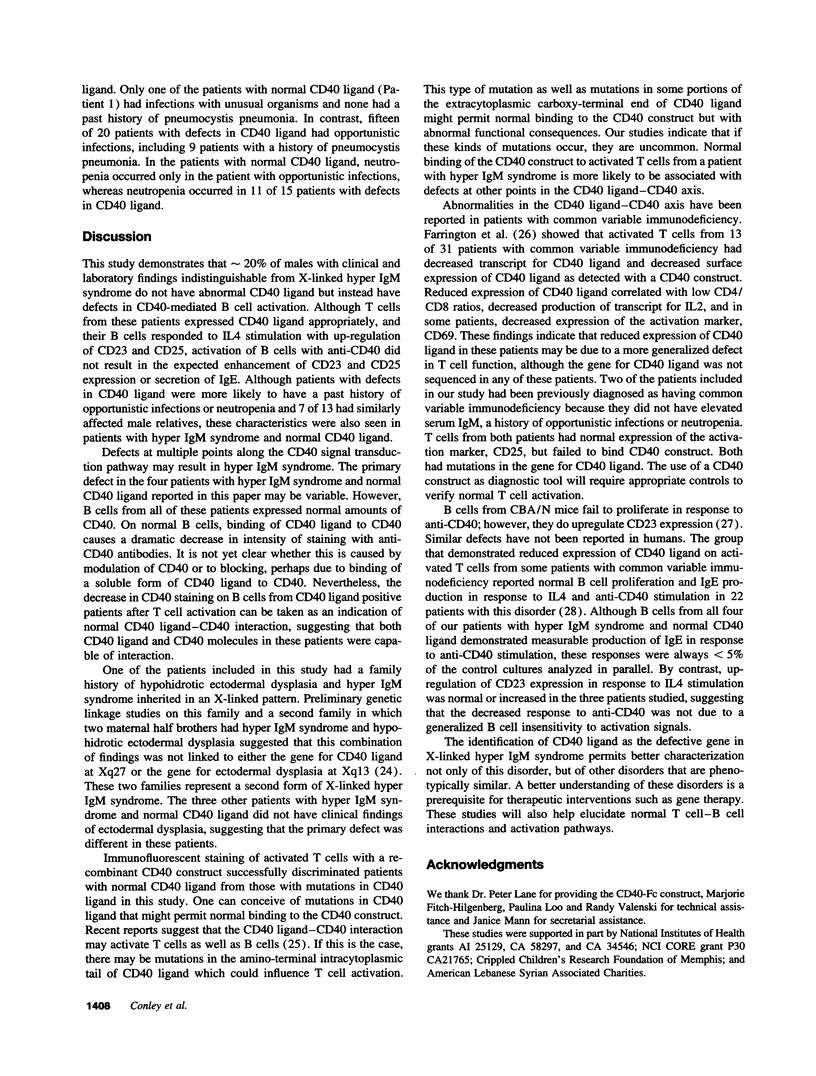
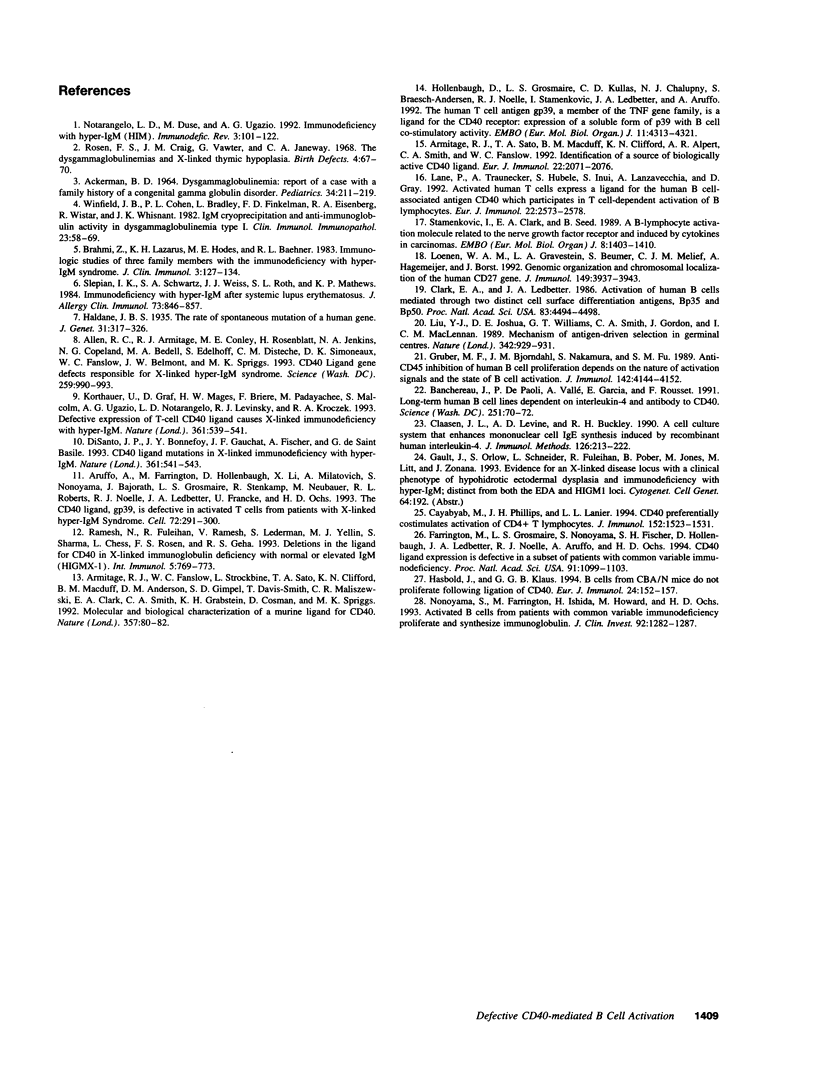
Images in this article
Selected References
These references are in PubMed. This may not be the complete list of references from this article.
- ACKERMAN B. D. DYSGAMMAGLOBULINEMIA: REPORT OF A CASE WITH A FAMILY HISTORY OF A CONGENITAL GAMMA GLOBULIN DISORDER. Pediatrics. 1964 Aug;34:211–219. [PubMed] [Google Scholar]
- Allen R. C., Armitage R. J., Conley M. E., Rosenblatt H., Jenkins N. A., Copeland N. G., Bedell M. A., Edelhoff S., Disteche C. M., Simoneaux D. K. CD40 ligand gene defects responsible for X-linked hyper-IgM syndrome. Science. 1993 Feb 12;259(5097):990–993. doi: 10.1126/science.7679801. [DOI] [PubMed] [Google Scholar]
- Armitage R. J., Fanslow W. C., Strockbine L., Sato T. A., Clifford K. N., Macduff B. M., Anderson D. M., Gimpel S. D., Davis-Smith T., Maliszewski C. R. Molecular and biological characterization of a murine ligand for CD40. Nature. 1992 May 7;357(6373):80–82. doi: 10.1038/357080a0. [DOI] [PubMed] [Google Scholar]
- Armitage R. J., Sato T. A., Macduff B. M., Clifford K. N., Alpert A. R., Smith C. A., Fanslow W. C. Identification of a source of biologically active CD40 ligand. Eur J Immunol. 1992 Aug;22(8):2071–2076. doi: 10.1002/eji.1830220817. [DOI] [PubMed] [Google Scholar]
- Aruffo A., Farrington M., Hollenbaugh D., Li X., Milatovich A., Nonoyama S., Bajorath J., Grosmaire L. S., Stenkamp R., Neubauer M. The CD40 ligand, gp39, is defective in activated T cells from patients with X-linked hyper-IgM syndrome. Cell. 1993 Jan 29;72(2):291–300. doi: 10.1016/0092-8674(93)90668-g. [DOI] [PubMed] [Google Scholar]
- Banchereau J., de Paoli P., Vallé A., Garcia E., Rousset F. Long-term human B cell lines dependent on interleukin-4 and antibody to CD40. Science. 1991 Jan 4;251(4989):70–72. doi: 10.1126/science.1702555. [DOI] [PubMed] [Google Scholar]
- Brahmi Z., Lazarus K. H., Hodes M. E., Baehner R. L. Immunologic studies of three family members with the immunodeficiency with hyper-IgM syndrome. J Clin Immunol. 1983 Apr;3(2):127–134. doi: 10.1007/BF00915483. [DOI] [PubMed] [Google Scholar]
- Cayabyab M., Phillips J. H., Lanier L. L. CD40 preferentially costimulates activation of CD4+ T lymphocytes. J Immunol. 1994 Feb 15;152(4):1523–1531. [PubMed] [Google Scholar]
- Claassen J. L., Levine A. D., Buckley R. H. A cell culture system that enhances mononuclear cell IgE synthesis induced by recombinant human interleukin-4. J Immunol Methods. 1990 Feb 9;126(2):213–222. doi: 10.1016/0022-1759(90)90153-m. [DOI] [PubMed] [Google Scholar]
- Clark E. A., Ledbetter J. A. Activation of human B cells mediated through two distinct cell surface differentiation antigens, Bp35 and Bp50. Proc Natl Acad Sci U S A. 1986 Jun;83(12):4494–4498. doi: 10.1073/pnas.83.12.4494. [DOI] [PMC free article] [PubMed] [Google Scholar]
- DiSanto J. P., Bonnefoy J. Y., Gauchat J. F., Fischer A., de Saint Basile G. CD40 ligand mutations in x-linked immunodeficiency with hyper-IgM. Nature. 1993 Feb 11;361(6412):541–543. doi: 10.1038/361541a0. [DOI] [PubMed] [Google Scholar]
- Farrington M., Grosmaire L. S., Nonoyama S., Fischer S. H., Hollenbaugh D., Ledbetter J. A., Noelle R. J., Aruffo A., Ochs H. D. CD40 ligand expression is defective in a subset of patients with common variable immunodeficiency. Proc Natl Acad Sci U S A. 1994 Feb 1;91(3):1099–1103. doi: 10.1073/pnas.91.3.1099. [DOI] [PMC free article] [PubMed] [Google Scholar]
- Gruber M. F., Bjorndahl J. M., Nakamura S., Fu S. M. Anti-CD45 inhibition of human B cell proliferation depends on the nature of activation signals and the state of B cell activation. A study with anti-IgM and anti-CDw40 antibodies. J Immunol. 1989 Jun 15;142(12):4144–4152. [PubMed] [Google Scholar]
- Hasbold J., Klaus G. G. B cells from CBA/N mice do not proliferate following ligation of CD40. Eur J Immunol. 1994 Jan;24(1):152–157. doi: 10.1002/eji.1830240123. [DOI] [PubMed] [Google Scholar]
- Hollenbaugh D., Grosmaire L. S., Kullas C. D., Chalupny N. J., Braesch-Andersen S., Noelle R. J., Stamenkovic I., Ledbetter J. A., Aruffo A. The human T cell antigen gp39, a member of the TNF gene family, is a ligand for the CD40 receptor: expression of a soluble form of gp39 with B cell co-stimulatory activity. EMBO J. 1992 Dec;11(12):4313–4321. doi: 10.1002/j.1460-2075.1992.tb05530.x. [DOI] [PMC free article] [PubMed] [Google Scholar]
- Korthäuer U., Graf D., Mages H. W., Brière F., Padayachee M., Malcolm S., Ugazio A. G., Notarangelo L. D., Levinsky R. J., Kroczek R. A. Defective expression of T-cell CD40 ligand causes X-linked immunodeficiency with hyper-IgM. Nature. 1993 Feb 11;361(6412):539–541. doi: 10.1038/361539a0. [DOI] [PubMed] [Google Scholar]
- Lane P., Traunecker A., Hubele S., Inui S., Lanzavecchia A., Gray D. Activated human T cells express a ligand for the human B cell-associated antigen CD40 which participates in T cell-dependent activation of B lymphocytes. Eur J Immunol. 1992 Oct;22(10):2573–2578. doi: 10.1002/eji.1830221016. [DOI] [PubMed] [Google Scholar]
- Liu Y. J., Joshua D. E., Williams G. T., Smith C. A., Gordon J., MacLennan I. C. Mechanism of antigen-driven selection in germinal centres. Nature. 1989 Dec 21;342(6252):929–931. doi: 10.1038/342929a0. [DOI] [PubMed] [Google Scholar]
- Loenen W. A., Gravestein L. A., Beumer S., Melief C. J., Hagemeijer A., Borst J. Genomic organization and chromosomal localization of the human CD27 gene. J Immunol. 1992 Dec 15;149(12):3937–3943. [PubMed] [Google Scholar]
- Nonoyama S., Farrington M., Ishida H., Howard M., Ochs H. D. Activated B cells from patients with common variable immunodeficiency proliferate and synthesize immunoglobulin. J Clin Invest. 1993 Sep;92(3):1282–1287. doi: 10.1172/JCI116701. [DOI] [PMC free article] [PubMed] [Google Scholar]
- Notarangelo L. D., Duse M., Ugazio A. G. Immunodeficiency with hyper-IgM (HIM). Immunodefic Rev. 1992;3(2):101–121. [PubMed] [Google Scholar]
- Ramesh N., Fuleihan R., Ramesh V., Lederman S., Yellin M. J., Sharma S., Chess L., Rosen F. S., Geha R. S. Deletions in the ligand for CD40 in X-linked immunoglobulin deficiency with normal or elevated IgM (HIGMX-1). Int Immunol. 1993 Jul;5(7):769–773. doi: 10.1093/intimm/5.7.769. [DOI] [PubMed] [Google Scholar]
- Slepian I. K., Schwartz S. A., Weiss J. J., Roth S. L., Mathews K. P. Immunodeficiency with hyper IgM after systemic lupus erythematosus. J Allergy Clin Immunol. 1984 Jun;73(6):846–857. doi: 10.1016/0091-6749(84)90458-5. [DOI] [PubMed] [Google Scholar]
- Stamenkovic I., Clark E. A., Seed B. A B-lymphocyte activation molecule related to the nerve growth factor receptor and induced by cytokines in carcinomas. EMBO J. 1989 May;8(5):1403–1410. doi: 10.1002/j.1460-2075.1989.tb03521.x. [DOI] [PMC free article] [PubMed] [Google Scholar]
- Winfield J. B., Cohen P. L., Bradley L., Finkelman F. D., Eisenberg R. A., Wistar R., Jr, Whisnant J. K. IgM cryoprecipitation and anti-immunoglobulin activity in dysgammaglobulinemia type I. Clin Immunol Immunopathol. 1982 Apr;23(1):58–69. doi: 10.1016/0090-1229(82)90070-8. [DOI] [PubMed] [Google Scholar]



